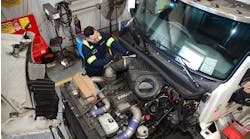Sustainability has evolved past being a corporate buzzword, and an organization’s ability to demonstrate its environmental bona fides is quickly becoming table stakes in many industries. Trucking is among them, with the push for transportation businesses to reduce their carbon footprints being driven by government regulation, changing customer requirements, and increasing consumer demand for sustainable supply chains.
Motor carriers may feel they are in a state of limbo as “aggressive timelines” for moving away from internal combustion engines (as described by American Transportation Research Institute) bump up against operational realities such as the expense of zero-emission vehicles, the dearth of charging infrastructure in the U.S., and the need to keep trucks moving to maintain a viable business.
This transitional period, then, requires transitional strategies—facilitated by actionable data insights, advanced AI technology, and proactive vehicle inspection and maintenance—that enable fleets to lower emissions while still using their diesel vehicles.
Artificial intelligence and sustainability
Much of the current conversation about artificial intelligence (AI) revolves around tools for research and writing, image generators and the like. AI also has many exciting applications for the trucking industry to help carriers better navigate an increasingly complex regulatory and operational landscape—and meet their emissions reduction goals.
AI’s ability to analyze vast amounts of data (machine learning) and make predictions delivers key benefits to trucking businesses. In terms of sustainability, AI-powered predictive maintenance can alert carriers to issues affecting vehicle performance and predict when breakdowns may occur. This information empowers carriers to be proactive in maintaining and optimizing their vehicles to reduce emissions through improved performance while increasing efficiency and vehicle life and preventing costly breakdowns and unplanned maintenance.
Read more: How AI is becoming the ultimate shop assistant
In addition to predictive maintenance, AI can be applied to route optimization, fuel efficiency monitoring, vehicle tracking and, in the case of the cold chain, advanced temperature monitoring and reefer control, all of which contribute to operational sustainability.
As AI matures, it could also automate routine tasks like maintenance scheduling, reefer management, and route optimization, lightening operational burdens and further addressing industry challenges. As this technology continues to evolve, its integration into transportation and logistics will redefine industry standards, shaping a future of innovation and efficiency. By harnessing the power of AI, trucking businesses can navigate complexities, optimize operations, and chart a course toward sustainable growth amid change and uncertainty.
Fuel usage and driver behavior reporting
When it comes to optimizing trucking operations, the aphorism “if you can’t measure it, you can’t improve it” holds true. Today’s technology gives fleets the ability to aggregate and contextualize data from telematics, transportation management systems, IoT sensors, and myriad other sources to measure many aspects of their operations and, ultimately, improve them.
Fuel usage and driver behavior are two key areas where actionable insights derived from vehicle data can be especially impactful for sustainability goals specifically and operational goals in general.
Fuel usage reporting – which reveals trends over time – can help carriers optimize fuel economy across their fleet (including fuel used to power reefer units). Moreover, monitoring fuel use can help carriers identify engine health issues that can sabotage emissions goals. If a truck’s average miles per gallon, for instance, suddenly drops by half, it can indicate a maintenance issue.
Driver behavior can have a significant impact on fuel economy, emissions, and vehicle life as well. Telematics reporting can help carriers identify and address poor driving practices, including rapid acceleration, harsh cornering, speeding, and hard braking. In addition, data enables carriers to identify engine idling trends, allowing them to implement changes to avoid the wasted fuel and wear and tear associated with unnecessary idling.
Driver vehicle inspection reports
Driver vehicle inspection reports (DVIR) are important for ensuring vehicle safety. They can also help identify issues that can negatively affect operational efficiency and sustainability – especially when it comes to tire pressure. Underinflated tires result in poor fuel economy and premature tire failure, with the general rule of thumb being that a 10% loss of inflation equates to a 1% drop in fuel economy. And underinflation is a pervasive problem: In 2020, the North American Council for Freight Efficiency found that 1 in 5 trucks/tractors were operating with at least one tire underinflated by 20 psi.
Making sure that drivers perform pre- and post-trip inspections is an easy way to ensure that correct tire pressures are maintained. Electronic DVIRs (E-DVIR) and app-based DVIR tools make the process even easier. In addition to DVIRs, sensors for trailer tires deliver information about tire pressure, temperature, and overall health in real time to improve safety and efficiency.
Harnessing the power of artificial intelligence and advanced data reporting, along with ensuring that physical vehicle inspections are completed, can help carriers begin to reduce their emissions today, while improving efficiency and safety and charting the course for true operational transformation and a more sustainable future.




